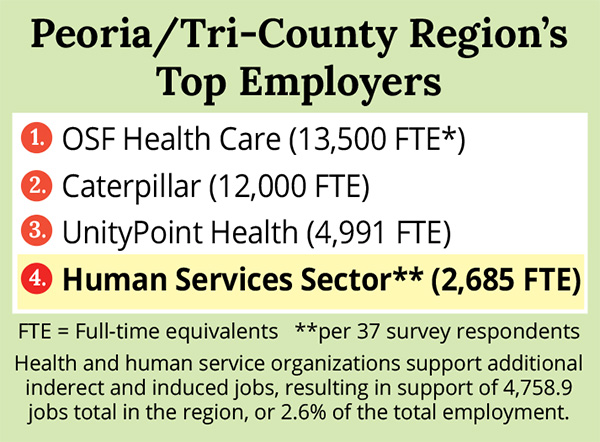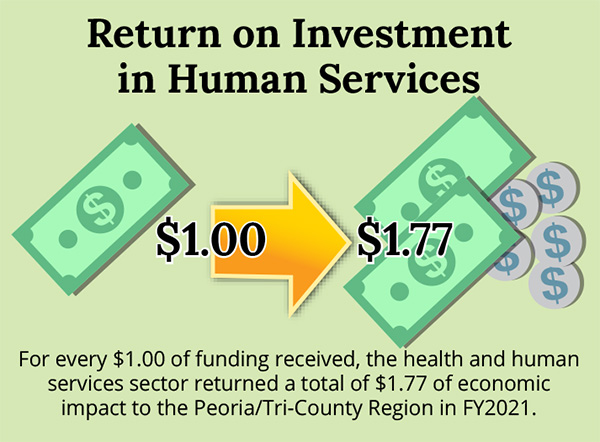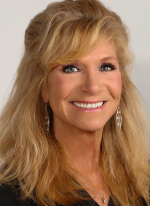Human Services Worth The Investment

Can you guess what business sector is the fifth largest employer in central Illinois, returns $1.77 for every $1 invested, and has brought in more than $121 million of state and federal funding to our local economy?
Most people do not realize the huge economic impact that the non-profit human services sector has on greater Peoria.
Small businesses, corporations and individuals are often called upon to donate money, attend events, or volunteer. Those actions not only directly help the human services organizations but also help to stimulate our local economy.
For the fourth time in the last 12 years, an economic impact study conducted by the Human Services Collaborative of Greater Peoria and the Illinois Partners for Human Services tells the story of what an essential role the human service sector plays as an employer, investor and spender in the Tri-County Area.
The Human Services Collaborative of Greater Peoria is a network of agencies that provide unique and crucial services, with a collective mission of building and leveraging support for everyone’s well-being.
THE FIFTH-LARGEST LOCAL EMPLOYER
 Staff in this sector are as diverse as our community. They are childcare workers, hospital/medical employees, teenagers taking on their first jobs, highly skilled professionals and people with disabilities, to name a few.
Staff in this sector are as diverse as our community. They are childcare workers, hospital/medical employees, teenagers taking on their first jobs, highly skilled professionals and people with disabilities, to name a few.
“The study shows me that four of the five top employers mentioned are employed in fields that directly serve others, making the culture of the Peoria area one of compassion and caring,” said Claire Crone, program manager at Sophia’s Kitchen.
“The Peoria area human services sector is the fifth largest employer in central Illinois and probably the most passionate,” added Jamie Durdel, president and CEO of the Tazewell County Resource Center. “Despite challenges like two years without a state budget and another two years of delivering services during the pandemic, our organizations were resilient and creative and determined to be there for the long haul.”
“Our staff are valuable assets to the local economy,” concluded Jeannine McAllister, executive director of Advocates for Access. “We boost the workforce numbers and raise the professionalism of that workforce.”
A GREAT RETURN ON INVESTMENT
 The human service sector “is a great investment,” said Jim Runyon, interim executive director of The Autism Collective. “We not only support the quality of life in the community, but every dollar given, earned, or raised … returns almost another dollar in real investment in the wider community.”
The human service sector “is a great investment,” said Jim Runyon, interim executive director of The Autism Collective. “We not only support the quality of life in the community, but every dollar given, earned, or raised … returns almost another dollar in real investment in the wider community.”
Given the high demand for their services and meager budgets, human service leaders squeeze the most out of every dollar. No organization wants to turn anyone away who comes to its door. Volunteers play an important role in the missions of most nonprofit organizations. They provide governance on boards and committees, fundraise, provide on-call emergency back-up, do spring and fall grounds clean-up, etc.
Human service organizations often are the recipients of donated supplies, furnishings and expertise, which stretch their budgets.
“Our volunteers are highly trained pilots who use their unique skill to fly people with medical needs far from home,” said Lindsey Kerr, executive director of Lifeline Pilots. “Our local pilots donated $94,000 of in-kind flight costs to fly 37 flights for people in Peoria this last year, which literally helps to ‘fuel’ our economy.”
A SUBSTANTIAL ECONOMIC RIPPLE EFFECT
 “I think the community needs to understand that we are a part of the economic well-being of the area and that we are not just ‘there with our hand out’,” said Patti Gratton, executive director of Community Workshop & Training Center Inc.
“I think the community needs to understand that we are a part of the economic well-being of the area and that we are not just ‘there with our hand out’,” said Patti Gratton, executive director of Community Workshop & Training Center Inc.
Human service organizations help build a better workforce for the whole community. More people in the community are employed and therefore more money is spent in the community. Additionally, many human service organizations train persons with disabilities to enter the workforce. When people with personal challenges find greater stability, that results in more productive employees for all businesses. Finally, the organizations themselves buy supplies, insurance, equipment and services, which adds to the general economy.
“Human services are a key part of the regional economy and should be at every table when policy is discussed and key decisions are made,” said Runyon.
LEVERAGING GOVERNMENT INVESTMENT
 Private funding leverages government dollars to our economy. Both income sources are essential. Yet the requests for assistance from the human services sector are far greater than the dollars available. When the community invests in human services, more “outside dollars” become available.
Private funding leverages government dollars to our economy. Both income sources are essential. Yet the requests for assistance from the human services sector are far greater than the dollars available. When the community invests in human services, more “outside dollars” become available.
“Public funds support the common good, and the human service sector uses those funds efficiently and effectively,” said Kim Cornwell, president and CEO of EP!C. “Private contributions and charitable support cannot replace these public funds.”
MAXIMIZING THE IMPACT
The Human Services Collaborative is a joint effort of dozens of local health and human services organizations that collectively work to promote the sector as an essential local employer, investor and spender. The 2021 economic impact study proves that every dollar invested in human services produces a strong return to the region’s broader economic well-being.
As a significant contributor to the gross domestic product of central Illinois, the Human Services Collaborative is and should be an essential part of community decision-making for the betterment of all.
For more information visit: humanservicescollaborative.com or the individual websites of its agency members.

Jeannine McAllister, executive director
of Advocates for Access

Jim Runyon, interim executive director
of The Autism Collective

